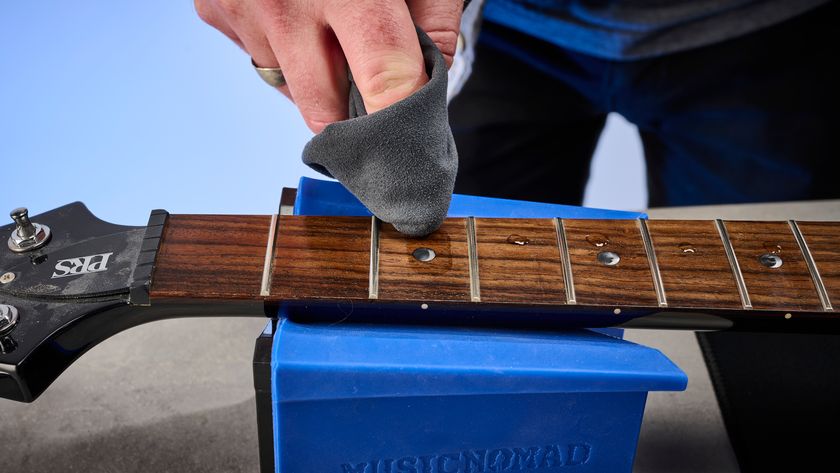Round-up: 4 great low-powered tube amp heads
Valve guitar amplifiers from Orange, Hayden, Blackstar and Jet City
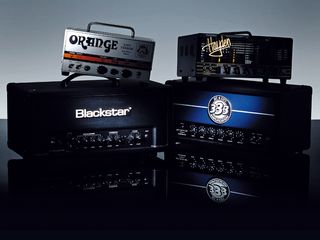
4 great low-powered tube amp heads
Something’s happening in the world of amplifier heads.
Take a stroll through a trade show in 2010 and you’ll still see the big boys, stacked up like leather breeze blocks, atop monster cabinets, for the delectation of well heeled punters still stuck in the ‘big is best’ mindset of 70s stadium rock.
Increasingly popular, though, are the new breed of so-called lunchbox amps: smaller, lighter and cheaper versions of all-valve heads that run at lower power (usually a maximum of 20 watts), reach their sonic ‘sweet spot’ at more practical volumes, and hop aboard any cabinet you fancy.
The recent lunchbox craze is widely credited to Orange’s Tiny Terror, so for this group test, we brought in that model’s classy Hard Wired brother (£663). As the only non-PCB model (ie, it doesn’t use a printed circuit board, but features point-to-point hand wiring), there’s no doubting the Orange’s psychological advantage here, but it will have a fight on its hands against the much cheaper contestants in the test.
Such competition comes in the form of Hayden’s Mini-MoFo (£329), Jet City’s JCA20H (£319) and Blackstar’s HT Studio 20H (£379).
To keep things equal, we’ll be testing all four heads through the same 2x12 cabinet, and playing Back In Black at least once on each. Heads up…
First up: Orange Tiny Terror Hard Wired Edition review
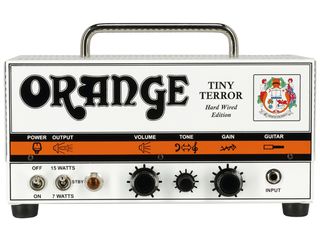
Orange Tiny Terror Hard Wired Edition review
Review
The Tiny Terror started it all, and the upgraded version might finish this group test. The smallest chassis conceals the most hardcore spec, with ECC83/EL84 valves, hand-wired point-to-point circuitry, and a choice of 15/7-watt output tailoring the Terror to any context. We’d tell the other amps to go home now… were it not for that non-tiny price tag.
Ear heaven. It’s the only way to describe the Tiny Terror’s loud, old-fashioned, ever-so-British valve bark, which belies its housebrick dimensions and sets a sky-high standard for its rivals.
With no effects, and only Tone/Gain/Volume controls, it seems sonically limited, but absolutely isn’t: you’ll start with the full, responsive, quacky punch of the test’s most characterful clean tone, before losing yourself in gritty, tight-bodied distortion that makes rock and blues riffs come alive (you’ll need a pedal for hardcore metal).
The output selector is also a neat touch - push the Terror into the red, and you’ll unlock the test’s best ‘sweet spot’ wherever you are.
In use
(Click here for demo recording settings)
Next: Orange Tiny Terror Hard Wired Edition verdict
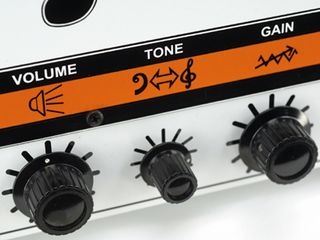
Orange Tiny Terror Hard Wired Edition verdict
Verdict
Just for a moment, let’s pretend money is no object. In this fantasy world, we’d choose the Tiny Terror over the other three, not just because it sounds like the distillation of rock ’n’ roll, but also because its ‘carry anywhere’ vibe nails the lunchbox concept to perfection.
Back to economic reality, though, and we just can’t give the nod to an amp that doubles the price demands of its closest rival. It’s the best – but not by double.
4 out of 5
Pros: Heavenly valve tone.
Cons: Priciest by a mile.
Next: Hayden Mini-MoFo review
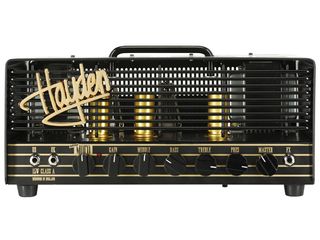
Hayden Mini-MoFo review
Review
Like Goodfellas’ Tommy D, this amp’s a scaled-down psychopath, packing 15-watt, five-valve grunt in a mean-looking steel chassis, and sweetening the deal with such gig-friendly trimmings as tone- tailoring US/UK inputs and an additional gain stage activated via footswitch.
The PCB format and Chinese origin don’t scream ‘investment!’ like the Orange, but the price ain’t so crippling either. The Mini-MoFo feels like a live weapon, rather than a studio luxury. Built like a tank, with chunky dials, it gives comprehensive command over your tone, even if that tone isn’t the strongest in the test.
There’s a tendency to play woolly, old-school blues with valve amps, but the MoFo has more attitude: plug into the ‘US’ input (for more edge than the bassier ‘UK’), crank the Presence and Gain, cut the Mid, and you’ve got the most convincing metal voice in the test, with the ‘Mini-MoFo’ boost best applied to solos. That said, when you’re stroking through clean chords, there’s better here.
In use
(Click here for demo recording settings)
Next: Hayden Mini-MoFo verdict
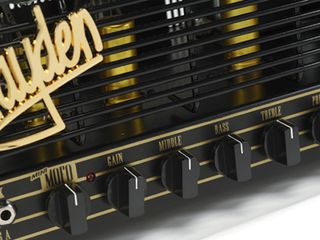
Hayden Mini-MoFo verdict
Verdict
For £329, you can’t really knock the Mini-MoFo: it’s as well executed as many British amps, has a level of tweakability that most valve heads don’t, and lives up to the aggression of its name.
At the same time, testing it after the Orange can’t help but reduce what would otherwise be hands-aloft hysteria to strong approval.
This is a damn good amp - but it’s all relative.
4 out of 5
Pros: Price, aggressive tone, features.
Cons: Lacks some tonal character.
Next: Jet City JCA20H review
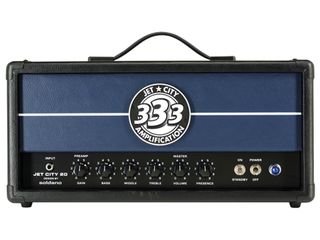
Jet City JCA20H review
Review
The Jet City motto pledges “100% tube tone, 0% bull****”, and given this is the new firm of US amp hero Mike Soldano (TG introduced the brand in last issue), it’s a ratio you can believe. In fact, so devoid of bull’ is the JCA20H that it has “no gimmick features to dilute the signal” and only the bare tone-shaping bones of Volume, Gain, EQ and Presence.
Arrogant in its simplicity and a little heftier than you’d expect from a lunchbox, the JCA20H quickly sets out its stall as the choice of the valve purist.
At 20 watts, this beast has power to burn; as with the MoFo it also has three 12AX7 preamp tubes that are voiced to produce the luxurious cleans and a fat, swaggering overdrive, which always retain a certain warmth and bottom end, however far you roll the Treble.
Jet City says its heads are not made for “smooth jazz”, and we’d go along with that. Pushed into the red, this amp runs hot and ballsy, and the response means you’ll play harder too.
In use
(Click here for demo recording settings)
Next: Jet City JCA20H verdict
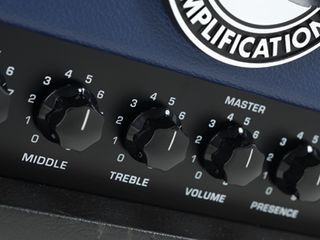
Jet City JCA20H verdict
Verdict
This test just gets tougher… with another head that would storm the podium were it not for the quality of the competition.
Don’t expect the performance of Soldano’s boutique models, but there’s no doubting the JCA20H is a valve head punching above its price tag, with power and girth (sonic and literal) that means you’d struggle to tell it apart from many full-sizers.
It’s worth a road test, and maybe more, if you can resist the next contender.
4 out of 5
Pros: Warm, ballsy tone, power, price.
Cons: May be too simple for some.
Next: Blackstar HT Studio 20H

Blackstar HT Studio 20H review
Review
Previously regarded as plucky British upstarts, Blackstar is fast becoming the A-lister’s choice, with everyone from Opeth to The Gaslight Anthem rolling out the flagship Series One and Artisan.
The HT Studio is less swanky, but might break the deadlock in a tough test with twin channels, EL34 valves, its tone-shaping ISF, onboard reverb and a monster 20 watts. If it had no trimmings, we’d still love the HT Studio.
At 20 watts, it’s loud enough to crack the earth’s crust, but this isn’t just a racket. When you play clean, it’s got depth, body and soul; add reverb and you’ve got killer atmospherics; hit the Gain for a punishing tone with more muscle than the rivals (probably due in part to the EL34s).
What really swings it is the flexibility of the ISF (from brittle to booming) and the gig-friendly option of stomping between dedicated channels, cementing the impression of an amp that’s sweet enough for the studio, but practical enough for the road.
In use
(Click here for demo recording settings)
Next Blackstar HT Studio 20H verdict
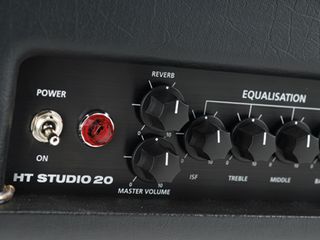
Blackstar HT Studio 20H verdict
Verdict
No, we haven’t backtracked on the Orange: it still has the sweetest valve tone in this test. But our decision is based on the bigger picture, and having chewed over the ratio of thrills given to pounds spent, the top spot goes to the Blackstar.
For £379, this is a bulletproof head, with buckets of tweakable tone, imaginative features – and no obvious weak points.
5 out of 5
Pros: Excellent, rounded performance.
Cons: Money aside, TT has an edge.
Liked this? Now read: 7 best low-powered tube amp heads under £300
Connect with MusicRadar: via Twitter, Facebook and YouTube
Get MusicRadar straight to your inbox: Sign up for the free weekly newsletter
Most Popular






